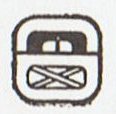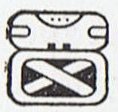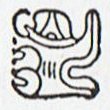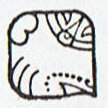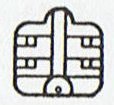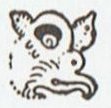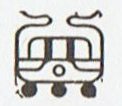6. Probably, I think, the Tree in the rongorongo 'vocabulary' is represented by the glyph type niu:
2-29 could allude to the next but last glyph on side a, where tagata at left is the same person as the central tagata:
The central tagata has a pointed head, though not quite as extreme as in the upside down head in Gb1-7. Both tagata figures have shorter necks than tagata at left in Gb7-7. They also have shorter necks than in the preceding hanau glyph. Though the hanau type of glyph in G does not exhibit a variable neck length - which suggests its neck (similar to that of tagata at left in Gb7-7) is of standard length. Usually a niu glyph has its 'branches' open (presumably depicting a dead old tree), but not so niu in Ga2-29. It ought to mean the Tree is fully alive for once. The king has survived the attack from the spear. If niu glyphs normally were used to indicate the final of the Tree (Jupiter), then it could explain why niu glyphs usually have open branches, e.g. as in Eb7-10:
... Sun has become completely dried out, he has become a skeleton, and in the form of One Hunaphu he 'spits into the right hand' of the maiden Blood Moon. The result should be that she will grow. The story of life moves on from Sun to Moon ... ... When viewed on end, the endocarp and germination pores give the fruit the appearance of a coco (also Côca), a Portuguese word for a scary witch from Portuguese folklore, that used to be represented as a carved vegetable lantern, hence the name of the fruit ... ... In Maya-land the month was Uniu (the Moon type of niu, I guess), or in Yucatec Kankin ('skeleton ribs'):
Niu is the tree which grows from the 'coconut', the dry old head of Spring Sun ... 7 'berries' in Eb7-9 could refer to 7 summer periods of Sun, e.g. as 7 * 26 = 182 days:
In the Mayan calendar Kankin is preceded by Mac, the 1st month beyond day number 12 * 20 = 240 (and also an exponent of the unlucky number 13):
Gates (An Outline Dictionary of Maya Glyphs) has the following explanation of his glyph type 340:
"... 340 may mean 'meat, flesh'. The two kinds of food, meat and bread in general, are sharply distinguished throughout Indian usage and language ..." After Sun's death they come to eat his flesh, I imagine, and then only his skeleton ribs will remain. I believe Sun could have been personified by a red deer (cfr the superfix of Ceh). "As a note to the colour red, we should remember that this word (or homonym) has two uses in several Mayance languages, and yet a third in the Maya of Yucatan. Chac means red, and is also an intenstive, 'very'. Chaccat in Kekchí translates the Zip glyph as 'red-?'. Chacavil is fever, and Chacekel tiger, in Maya; also intensive, chacetcun, to aggravate, increase. And similar forms in Quiché, Tzeltal, etc. And finally in Yucatan it is the common, still-known name of the Four Chacs, or Bacabs, rulers of the Quarters. Hatz'-chac may equally be read as fire-stick, heavy stroke, or 'bolt of the Chac' (Jupiter Tonans) ..." (Gates, a.a.) The Chac superfix has in Zip 3 dots in a bowl and in Ceh 6 dots in a cap:
Let us once again try to put in parallel the glyphs at the beginning of line Eb7 and the glyphs of the Mayan calendar:
|
|||||||||||||||||||||||||||||||||||||||||||||||||||||||||||||||||||||||||||||||||||||||||||||||||||||||||||||||||||||||||||||||||||||||||||||||||||||||||||||||||||||||||||||||||









